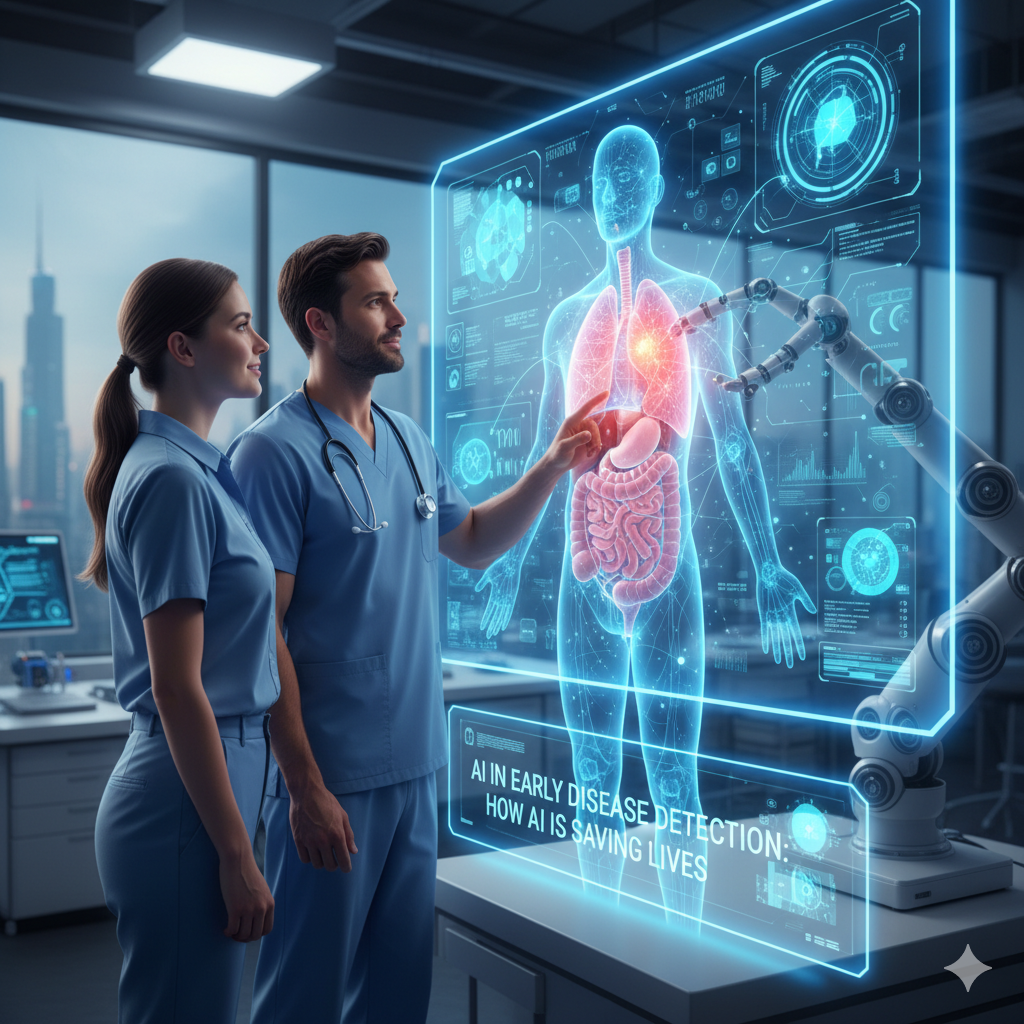🌍 Introduction – A New Era in Healthcare
AI has a revolution in how doctors spot and tackle diseases. AI helps doctors find illnesses , at times before patients show symptoms. From cancer and heart issues to diabetes and brain problems, AI enables doctors to make quicker and more precise choices.
🔍 What Is AI in Early Disease Detection?
AI in early disease detection uses computer programs that learn from data — like scans, lab tests, or health records — to identify the first signs of a disease.
For example:
- AI has the ability to examine X-rays or MRI scans and spot small changes that might escape a doctor’s notice.
- AI can review medical history, lifestyle, and lab results to forecast someone’s likelihood of falling ill.
- Clever wearable devices (such as watches or fitness bands) apply AI to monitor health information and alert users if something out of the ordinary occurs.
🧩 How AI Detects Diseases Early
AI functions by analyzing vast datasets from hospitals, labs, and health apps. Here’s a straightforward breakdown of how it operates:
- Gathers Data – AI collects medical images, test results, and health records.
- Recognizes Patterns – It examines data to identify what “healthy” and “unhealthy” look like.
- Forecasts Outcomes – It estimates who might have risks or show early signs.
- Supports Doctors – Doctors apply AI findings to verify results and choose treatments .
🏥 Real-World Examples of AI in Disease Detection
🧬 1. Spotting Cancer
AI systems like Google’s LYNA have an ability to detect breast cancer cells with over 90% accuracy. These systems can examine scans and spot tumors that humans can’t see.
❤️ 2. Spotting Heart Problems
AI can interpret ECG data or heart scans and alert doctors to possible heart attacks or blockages well before they occur.
👁️ 3. Stopping Vision Loss
AI can look at eye scans to find diabetic retinopathy, a common reason for blindness in people with diabetes.
🧠 4. Spotting Brain Issues
In diseases like Alzheimer’s or Parkinson’s, AI has an impact on recognizing minor changes in brain scans or speech that show up years before symptoms.
🦠 5. Tracking Infections and Epidemics
AI makes it easier to keep an eye on and forecast the spread of infectious diseases such as COVID-19 by examining worldwide health information and trends.
⚙️ Benefits of Using AI to Detect Issues
✅ Faster Diagnosis: AI has an impact on medical data analysis completing it quicker than humans.
✅ Better Accuracy: It cuts down on the likelihood of human mistakes.
✅ Lower Costs: Spotting issues helps avoid pricey treatments down the road.
✅ Personalized Care: AI customizes health plans to suit each individual.
✅ Preventive Health: It aids in stopping diseases before they turn serious.
⚠️ Challenges and Limitations
While AI packs a punch, it still faces hurdles:
- Data Privacy: We need to protect patient information .
- Bias: AI might produce unfair outcomes if it learns from limited data.
- Regulation: AI medical tools must clear tough safety checks.
- Human Oversight: Doctors continue to make the final calls.
🔮 The Future of AI in Healthcare
AI has an impact on health monitoring in real time. Wearable devices can track your body and alert doctors on their own. Hospitals already use AI to diagnose faster and more . In the years to come, healthcare will predict more than react helping people stay healthy instead of just treating sickness.
🧾 Conclusion – Predicting Diseases Before They Start
AI to detect diseases is not just about tech — it’s about keeping people alive. When AI finds illnesses , doctors and patients have more time to take action. The aim is clear: a world where AI helps stop diseases before they turn dangerous.
